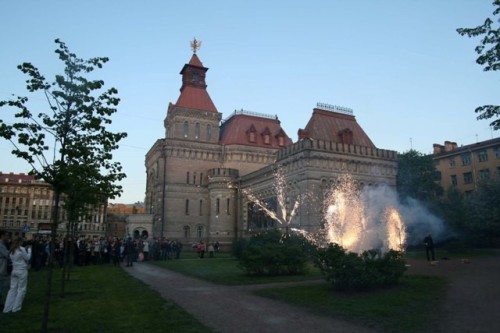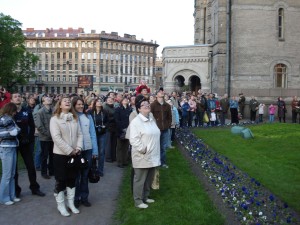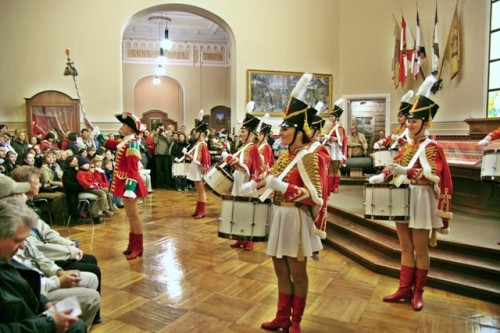
Hermitage St. Petersburg
Museumnacht in het licht
Half mei vierde Rusland zijn Museumnacht, een onderdeel van de internationale dag van het museum. Een feest van verleden in het heden. Kijk en lees. Een videoreportage staat onderaan de tekst (video program at the foot of this story) .
————————–

“MUSEUMS’ NIGHT…” At night from 16th to 17th of May, 2009 the action “Museums’ Night” was carried out in all Russian cities and towns. ”Museums’ Night” – is a yearly action, devoted to The International Museums Day. On the 16th of May more than 40 museums of Saint-Petersburg, from the smallest to the biggest ones opened their doors for visitors from 6 p.m. to 6 a.m. Each museum has prepared a program for this particular night, the only night in the year. In the museums the visitors were proposed to see: the one-day exhibitions, concerts, performances, unusual excursions, unexpected masterclass, staged performances and historical competitions.

During this night almost 2000 museums in Russia don’t sleep one night a year opening their doors for those who interested to see the museum in unusual period of time – in the evening and at night. This year in the frames of this event more than 40 museums, picture galleries, exhibition halls, libraries presented all the most pieces of their collections. They welcomed more than 24 thousands midnight visitors. All metro stations in Saint-Petersburg close after midnight therefore for people who expected to get home not too late some museums prepared the evening program from 6 p.m. to 11 p.m. And for those who was ready to walk by the morning around the city and watch the bridges lifting up above the Neva River the museums offered to take part in the night program which lasted 9 p.m. to 6 a.m.

The second year the initiator of the action “Museums’ Night” was the Culture Committee of Saint-Petersburg. The action was supported by the following public and social organizations, such as: the Committee on Youth Policy and Interaction with public organization, the Committee on Investments and Strategic Projects, Municipal tourist’s and information centre, the Transport Committee and the Central Administrative Board of Internal Affairs. The action was foregone by perfect advertising company. The web-site of the action wasn’t able to proceed with influx of visitors willing to get familiar with the program.

Suvorov Museum The Suvorov Memorial Museum in St. Petersburg, the historical capital city of Imperial Russia, is devoted to one of the greatest commanders of the World – Alexander Suvorov. His brilliant victories in the second half of the 18th century, in the Age of Enlightenment, Catherine the Great, and the French Revolution, not only gave territories and prestige to Russia and her European allies of that time, but also brought about glorious military traditions in Russia. Idolized by his contemporaries, “Immortal Suvorov” is popularly believed in Russia to have never lost any single battle during his decades-long combat activity in the East and the West.

- Suvorovmuseum
The Suvorov Museum has been the first memorial museum of Russia and also the third Russian museum to be housed in a specially constructed building. It was built by Emperor Nicholas II’s decree of 1899 under the direct patronage of the Czar and opened in the presence of His Majesty in 1904. Designed by architect Alexander von Gogen and constructed between 1901 and 1904, it stylistically borrows from old Russian fortress architecture, especially from the Kremlin in Moscow, to stress the fact that the museum is dedicated to the greatest Russian military leader. 17 May 2008, The Suvorov Memorial Museum together with many other museum institutions of St. Petersburg participated in the festivity “Museums’ Night”.

Despite the name of this very popular feast, the “Night” celebration started at the Suvorov Museum much earlier, at noon. This was done for young visitors, who enjoyed a fascinating presentation and theater show on the invincible Russian historic commander – Alexander Suvorov. Children and parents also attended the performance of the old famous film “Suvorov”, after which all of them took a quiz. Every boy and girl – rightly answering questions on Russian history, military, and culture – gained a present.

The night festivity, as such, consisted of a few amusing parts. First of all – “Evening at Suvorov’s”, when guests of the museum were given a warm reception and treated to traditional “Suvorov’s soldierly cuisine”, including a shot of vodka and a turnip sandwich. After this, all the museum visitors had a very informative guided tour, followed by a brilliant concert of classical music. The beginning of the outdoor program “May Thunder of Victory Sound!” was marked by a six-volley artillery salute. People, attracted by the canon shooting, as well as by music and drumming, turned out to see girl-drummers show; performance of a military band, and tremendous firework in the fashion of the 18th century.

We have bought entrance tickets, so called multi-use tickets. One ticked allowed visiting 25 of 40 museums. In reality we managed to see only 4 expositions. Moreover we faced the car parking problem. The only thing which caused joy to us was that there are many museums in Saint-Petersburg. Therefore it takes about 15 – 20 minutes walk by feet from one to another. Thus we parked our car near the Military-Historical Museum of Artillery, Engineer and Signal Corps and started on our night journey by feet. And the first object we visited was the very Military-Historical Museum of Artillery, Engineer and Signal Corps, where a part of exhibition is located in the open air. Military-Historical Museum of Artillery, Engineer and Signal Corps The official date of its foundation is August 29, 1703, when by Peter the Great decreed to build a special Zeughaus – a military storehouse for armaments, uniforms, equipment, etc. on the territory of the Saint-Petersburg. In was build up on the area of Peter-and-Paul fortress for the purpose of storing and preserving old guns and cannons. Originally this had been a small wooden structure that was later rebuilt with brick. Both Russian and captured guns and cannons and further the uniform, flags and banners from the whole area of the Russian Empire that were considered to have historical value were sent to this arsenal “for remembrance and future glory.”

- Pas op voor de ogen, heren!
The collection numbered up to 6 000 exhibits by the late 18th century. At that time there was not such a collection of armament objects anywhere else in the world. The Military-Historical Museum of Artillery, Engineer and Signal Corps became one of the most significant military-historical museums in the world for its more than 300 year history, a subject of national pride for Russia. It is a real temple of Russian military history, a division of eternity” within the Russian Armed Forces, as it is rightfully called. Nowadays it keeps the richest collections of weapon produced in Russia and 54 other countries all around the world since XIV century till today. These collections include personal weapon of world famous people such as Napoleon Bonaparte, the Earl Peter Shuvalov, unique experimental cannons of Andrei Nartov, Russian mechanical engineer and inventor.

There are military uniform of different historical periods, awards, pieces of sculpture and battle painting, documents and fortresses scale models. Its doors are always open for visitors who can expect to find an exciting meeting with the military history of Russia and of other countries of the world. But that night the most interesting events have happened in the museum’s yard. Here in the open air by the camp-fires the heroes of different historical ages set up together a large military-historical camp. There were Roman legionaries, medieval chivalry, Napoleon’s, German, Austrians, Russian army solders from the periods of the First and Second World Wars, as well Red Army and fascist solders. Normally in the museums it is not allowed to touch the exhibits, not to mention putting them on, for example chivalrous armour. During that only night we got an opportunity not only to see the military uniform and weapon, but to put it on, to try ourselves in archery and arbalest shooting, to learn pieces of the military weapons and equipment. As to me, I tried to shoot with revolver Walther P-08 produced in 1908. The solders were sitting around camp-fires, remembering past times, singing war songs. They told us what did solders and army officers of different countries in world eat, drink, what did they talk and think about and what did they believe in. In frames of the this program we watched a restoration of two battle episodes from The 1st World War and one episode from The 2nd World War. On the small area in the museum yard solders and officers of Russian and German armies showed us real battle scenes. We saw everything shooting, but with blank cartridges, garnets, attacks, hand-to-hand fighting, betrayer-deserters, the killed and wounded and nurses who brought wounded solders out of the battle. And of course the VICTORY above the enemy! It was a breathtaking performance. After the action children from the guests side rushed to the trenches to take a fired cartridge cases as a memory. Peter-and-Paul Fortress As I told the museum of artillery is located on the area of Peter-and-Paul Fortress. Thus we just crossed the road and find ourselves behind the fortress wall of the Russian major political prison in XIX century. There several small but very interesting expositions opened their doors for the night guests. During the action “Museums’ Night” the fortress guest were proposed to listen a concert of different styles of music in the Central Cathedral Square, to visit a unique historical exposition of an ancient graphics as well as the workshop which currently works.

We were able not only to watch, but to make by our own a lithograph or monotypy. In the restored building of Trubetskoy bastion there is a new exposition devoted to the history of the Russian major political prison for the period 1872 – 1921.

That night was the first time when the excursions were carried out in form of theater performances. History of the prison, destiny of the prisoners kept in its cells, peculiarities of regime and living conditions have been told us by the prisoners themselves, who were played by theatre actors. We have been shown three mono performances. Before the performance we’ve tasted prison porridge with meat, bred and water. One more mini-exhibition was like a miracle for us – something which is beyond the human abilities. In 2006 the International Guild of Craftsmen has opened the first Russian museum of microminiatures “Russian Levsha”. International Guild of Craftsmen – is a union of creative assemblies such as blacksmiths, designers, architects, stained glass masters, painters, puppet-makers, bards and other masters connected with art and useful arts. In Russian “Levsha” – is a name of literature hero and at the same time it means left-handed person, who always considered as non-ordinary and talented. The unique feature of the collection “Russian Levsha” is that all exhibits are smaller than one millimeter! Can you imagine this? In order to descry these pieces of work made by the Russian skilled craftsman Vladimir Aniskin it is possible only via the magnifying glasses integrated into the exhibition showcases. All these pieces of art are made sensu stricto of golden, silver, platinum dust as well as of ordinary grey domestic dust. The blacksmith’s work, casting, glass and birch bark treatment and jeweller’s art – all these useful arts allow creating amazing microminiatures. The exposition includes such exhibits as an iron-shod flea (the flea’s shoes width is 0.05mm, it is six millions times less than horseshoes), a camelcade within the eye of a needle (the camels height is 0.07-0.08 mm), an extract from the story “Levsha” written by N.S. Leskov, two printed pages on the cross-section of a rice grain, a rose on a horse-hair and many other amazing things.
We get acquainted with the secrets of the greatest Russian inventor, Levsha, and many interesting facts about left-handed person abilities.

Having visited Peter-and-Paul Fortress we went to the icebreaker “KRASIN” moored near the Neva River wharf. However the queue to come on board was too long, therefore we refused to wait until the morning and decided to visit Vasilyevskaya Fire Station, which is located within five minutes of walking distance from the wharf. Vasilyevskaya Fire Station The excursion of the old fire station on Vasilyevski Island called «The Fire-Warden asks you to be his guests». The fire-warden an actual head of the fire station met his guests in the square in front of the Vasilyevskaya fire station building. Both were dressed in uniform of XIX century. That night an old garage with fire cars and equipment of XIX century opened its doors for guests. And modern fire cars were exhibited in the square in front of the building. Here everyone was allowed to take photo sitting in the car with protective uniform of the “fire battle-front solders” on. On the other side of the square people tried use the water cannon and hit the football installed on the rack with the stream of water. Having waited for 2 hours and a half we got inside and many interesting and outstanding exhibits such as: steam-driven pump produced in 1863, an old fashioned gas-mask, copper helmets, scaled figures of the fire station chiefs, which visited very often the «The Fire-Warden private office». At about 3 o’clock in the morning we went to the last aims of our journey. They were and Yelagin Island Palace and Museum. Yelagin Island Palace and Museum We have arrived to the Central Park of Culture and rest about 4 o’clock in the morning. Unfortunately we didn’t see the sunset on the Yelagin Island – the culmination of the evening celebration in the Central Park. But the visitors told us that it was nice. In the evening the guests were met by the festival hosts, the Earl Yelagin, Maria Fedorovna, the empress, with her son Alexander I, and the Earl Alessandro Cagliostro and architect Carlo di Giovanni Rossi escorted by retinue. Everyone who wanted was invited by the Earl Yelagin and the Earl Alessandro Cagliostro to have a “White Nights Dance” in the accompaniment of the brass band. In the park it was possible to buy “Lucky bouquets” and “Forged couns”, which bring your home happiness and luck. The Palace guests could have a ride in a four-in-hand carriage around the park, put on a historical dresses, camisoles, ladies hats with plume and cocked hats, dance, taste royal food in the cafe and take photos in the palace halls, which were constructed by Carlo di Giovanni Rossi. Doors of the palace were wellcoming people fom the sunset till the sunrise. In each hall there were excursions, minispectacles. It looked like the historical characters were still living in the palace. When we came into the livingroom we saw three men and a lady dressed in masked suits; they were playing pocker. Our giude told us that in that particulr hall the empress and her guests had parties, amused, played chese and pocker, had polite and conversations. Every hour the Earl Alessandro Cagliostro performed his short magic performances. Among the other societarian entertaiments there were the “Royal hunting with hounds” in the meadow. Near the Yelagin Palace it was possible to buy some national homecraft goods and have a cap of tea from origin Russian samovar (like kettle but heated with coal and woodden chips). As to we, I bought a glove puppet, a hedgehog. I gave him an old Russian name – Evlampiy.

Everything I told is just a small part of those available for visitors that white night in Saint-Petersburg. So much the better for us – we have so many interesting events and meetings to come. And you too… It was great! Not a single minute there was boring! I invite all of you to our Northern Venice. Saint-Petersburg is more than usually wonderful and mysterious during the white nights period. May be that is the main reason, why or citizens like visiting museums at night. You are always welcome
www.youtube.com/view_play_list?p=C8F74389EFAF33B2&search_query=Museums%27+Night+in+Saint-Petersburg
www.youtube.com/watch?v=j1ki5du1Iz0
Plaats een reactie